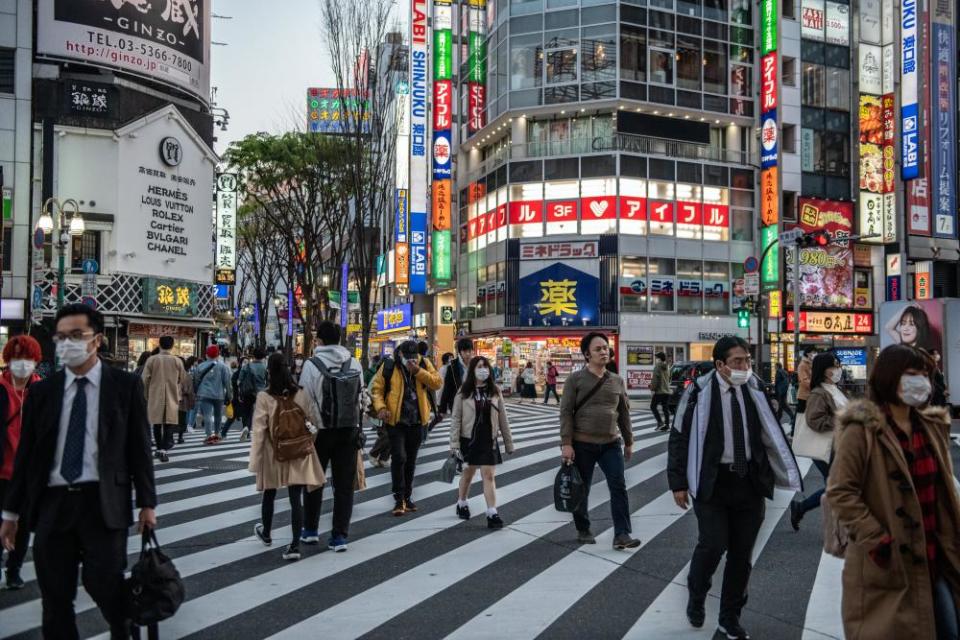Europe looks past lockdowns as US and Japan brace for coronavirus trauma

Europe’s governments have begun to look ahead to the post-lockdown phase of their battle against Covid-19 as curves on the continent flatten, while the US braces for “peak death week” and Japan prepares to declare a state of national emergency.
Austria on Monday became the first EU country to publicly announce plans to lift its restrictions. “The aim is that from April 14 ... smaller shops up to 400 square metres, as well as hardware and garden stores, can open again, under strict security conditions,” the chancellor, Sebastian Kurz, said.
If the government’s timetable goes to plan, larger shops could reopen on 1 May and hotels, restaurants and other services from mid-May, Kurz said, adding that “everything will depend” on whether citizens continue to obey draconian distancing rules this week and over the Easter break.
In Germany, the chancellor, Angela Merkel, said on Monday that the coronavirus pandemic was “the EU’s biggest test since its foundation” and thanked Germans for following the government’s instructions. But she added that it was still too early to set a date for lifting the country’s lockdown.
However, as Germany reported its its fourth consecutive daily drop in cases, a leaked interior ministry document revealed a list of measures that officials seemingly believe might allow public life to gradually resume after the end of the country’s lockdown, currently scheduled for 19 April.
The measures include an obligation to wear masks in public, limits on public gatherings, and mechanisms to allow more than 80% of people an infected person has been in contact with to be traced within 24 hours of diagnosis, permitting schools to reopen on a regional basis and strict border controls to be relaxed.
Like several EU countries, Austria and Germany look set to rely on mobile phone apps to trace citizens’ movements and warn them of potential risks of infection, prompting the bloc’s data protection supervisor on Monday to urge the development of a single, more secure pan-European app.

Spain, which has recorded the second highest Covid-19 death toll in the world so far after Italy, also reported a fourth consecutive fall in its daily death tally as well as falls in hospital admissions and critical care cases.
While strict confinement rules introduced on 14 March will remain in force until 26 April, the government announced on Monday that it is planning to widen coronavirus testing to include people without symptoms, as a first step towards slowly easing the lockdown.
“We are preparing ourselves for de-escalation, for which it will be very important to know who is contaminated,” said the foreign minister, Arancha González Laya.
Italy on Monday reported 636 deaths, roughly 100 more than the previous day, but its infection rate slowed again, with the number of new positive cases rising by under 2,000, or 2.1%. The health minister, Roberto Speranza, told the daily La Repubblica that the coming period was going to be hard.
“There are difficult months ahead,” he said. “Our task is to create the conditions to live with the virus,” at least until a vaccine arrives.
The daily death toll in France, which went into lockdown later than Spain and Italy, also fell on Sunday, to 357 from 441 in the previous 24 hours. The health ministry said hospital and intensive care admissions were also declining, but warned people it was still essential to continue respecting strict confinement measures.
default
According to the Johns Hopkins University tracker, the coronavirus has reached more than 210 countries and territories around the world, infecting 1.28 million people and killing more than 70,000. Nearly half of the world’s population is living in some form of lockdown.
Among other developments:
Norway said it considered its outbreak “under control” but cautioned it was too early to say if restrictions could be lifted.
As 51 African countries reported 9,198 cases of Covid-19 and 414 deaths, South Africa’s president, Cyril Ramaphosa, called for unity and a massive aid effort.
The trajectory of infections in Iran appears to have started a “gradual” decline, the government said.
Indonesia recorded its biggest daily jump in cases, with 218 confirmed on Monday, while the Philippines recorded 414 new infections.
Russia also recorded its biggest daily jump with 954 new cases of the disease.
France is facing its deepest recession since the end of the second world war, the finance minister, Bruno Le Maire, said.
But if curves are flattening in Europe, elsewhere there was little sign of a let-up. The Japanese prime minister, Shinzo Abe, said on Monday the government planned to declare a state of emergency and proposed a $1tn stimulus package.

Pressure has increased on the government to take action as Tokyo announced a record 148 new cases on Sunday, followed by 83 more on Monday. Japan is unlikely to introduce a hard lockdown, but the government will aim to exert strong psychological pressure through requests and instructions.
The total number of positive cases in Japan has nearly doubled in the last seven days, with Tokyo the main hub. A rapid spread of the virus is a huge risk in the Japanese capital, a city of nearly 14 million, and Japan has one of world’s oldest populations, with nearly a third of the population – 36 million people – over the age of 65.
In the US, authorities have warned the worst is yet to come. Officials on Monday told the country to prepare for a deadly week as the accelerating US death toll, currently approaching 10,000, closed the gap with Italy’s and Spain’s.
“It’s going to be the peak hospitalisation, peak ICU week and, unfortunately, peak death week,” said Adm Brett Giroir, a member of the White House coronavirus task force, raising the alarm in particular alarm for New York, New Jersey, Connecticut and Detroit.
The US total of 336,000 confirmed cases is by far the world’s largest and roughly twice as many people a day are dying in the US as in Spain and Italy.
Donald Trump suggested the country was starting to see “light at the end of the tunnel”. But Anthony Fauci, the director of the National Institute of Allergy and Infectious Diseases, said on Sunday that “doesn’t take away from the fact that tomorrow, the next day, are going to look really bad”.
The UN secretary general, António Guterres, on Monday urged governments to protect women from what he described as a horrifying rise in domestic violence as a consequence of coronavirus measures. “For many women and girls, the threat looms largest where they should be safest: in their own homes,” he said.
Guterres urged all governments to make “the prevention and redress of violence against women a key part of their national response plans for Covid-19”.

 Yahoo News
Yahoo News 
